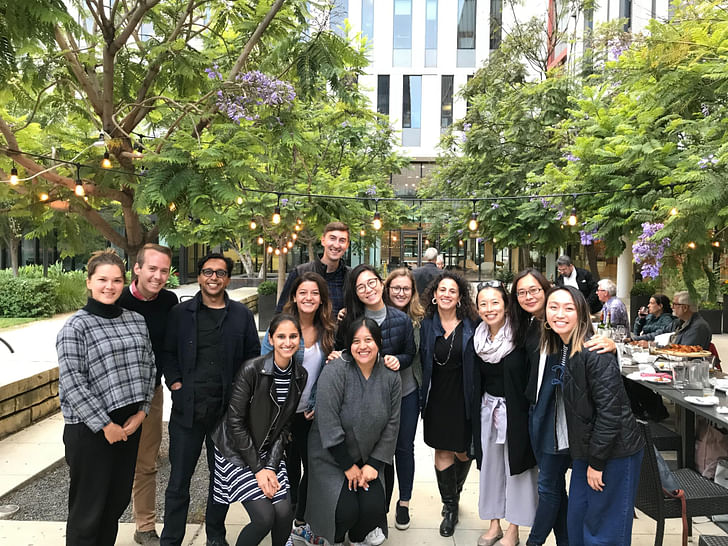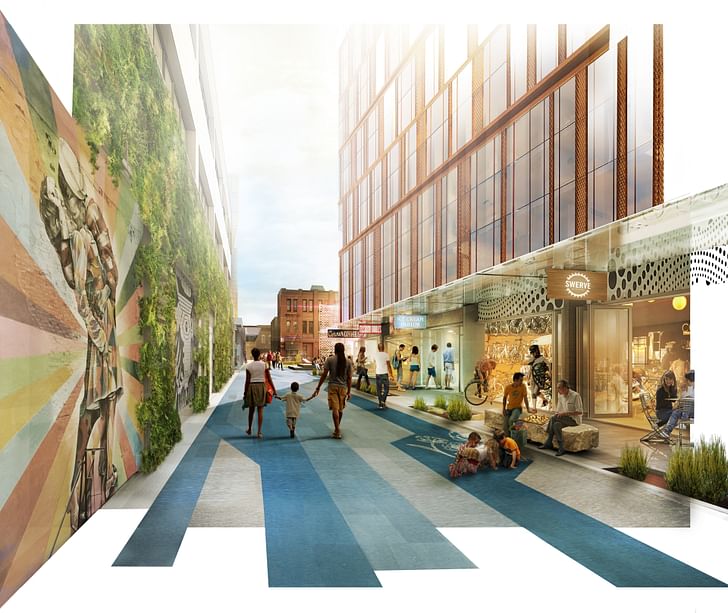

SITELAB urban studio is a multi-disciplinary urban design team based in San Francisco. The 16-person firm tackles a wide-ranging set of concerns through their work, which bridges between urban design, landscape architecture, community engagement, and placemaking focuses. Viewed simply, SITELAB urban studio endeavors to improve the spaces between and around buildings by working to recast "urban design as a social practice, beyond simply technical or formal study," according to the designers.
For this week's Studio Snapshot, we spoke with Laura Crescimano, co-founder of SITELAB urban studio to discuss the importance of working collectively as a practice, looking up to firms and designers that are blurring traditional definitions of practice, and how the firm brings a "holistic lens to design by co-creating places" with clients and project partners.
Where and when did your studio start?
I started SITELAB urban studio in 2012 in San Francisco with my colleague and dear friend Evan Rose. Both of us had already developed long-term projects and passions at other firms and decided to take the leap in creating our own urban design practice based on our shared values. In 2015, Evan Rose passed away to a rare form of cancer, and SITELAB has continued his tremendous legacy of passion and commitment to designing for public life.
How did you come up with your name and company ethos?
Naming is never easy. After casually batting different ideas around for a month or two, we each made a list of words and phrases we liked and sat down and highlighted our favorites, together with our pending first employee. Low and behold “SITELAB” was the only word we all agreed on—it expressed the sense of being specific to place, to experimentation and creativity, and importantly to a collective of designers and thinkers rather than having our names on the door. From there we knew we wanted “urban” to be in the name to be specific to our work on cities and places beyond specifically buildings or landscapes, and so SITELAB urban studio was born.

How many people work at the company?
We currently have 16 team members.
What made you make the decision to start an office?
Evan and I had a mutual obsession with recasting urban design as a social practice. Our diverse work backgrounds provided a lens to view space as more than just stand still, rather as a platform for experiences created by the community, context, culture, and the environment. We wanted to marry physical design with strategy, process, and storytelling in our work to make our cities and shared spaces better, so we started our own practice to do it.
Evan and I had a mutual obsession with recasting urban design as a social practice. Our diverse work backgrounds provided a lens to view space as more than just stand still, rather as a platform for experiences created by the community, context, culture, and the environment.
What are some other offices that you look at for guidance and why?
Most urban design practices are a part of larger Architecture and Engineering (A&E) firms. For us to be stand-alone as well as multidisciplinary in our approach left us with few direct parallels. So, for inspiration, we look to other firms and designers that are blurring boundaries and defying traditional definitions—like Interface Studio in Philadelphia, WXY and Scape in New York, Liz Ogbu and Studio O in Oakland and Kounkuey Design Institute (KDI) in Los Angeles.

What would you want your firm to be known for?
We want to be known for our impact and connection to the communities we foster through meaningful, sustainable design.
What were the first 365 days like?
We were three people, in a very tiny coworking space, focusing on only our first project, and then a second. The two projects were substantial: the 5M Project and Pier 70 in its early stages. It was (and honestly still is) a wild ride. We were fully immersed in the work and the excitement of bringing two major pieces of San Francisco to new life.
What were the biggest obstacles along the way?
In 2015, Evan Rose, SITELAB’s cofounder, died of cancer after defying it for many years. We were challenged to continue to work and progress SITELAB, one of his passions, while being there for a dear friend (who was still scheming project ideas even when he couldn’t work). We didn’t know what the business would look like without him. His optimism, his leap of faith to start SITELAB, and his creativity emboldened us to live up to his legacy.

What are you currently working on?
Variety is core to our practice. We are working on mixed-use new neighborhoods on behalf of Google for their headquarters in Mountain View and in San Jose (from 80-120 acres). We are just getting started working with the Port of San Francisco on long range resilience planning for the San Francisco waterfront (10 miles in length) and at the same time, we have smaller projects such as a pair of small temporary play spaces in East Palo Alto. We are also just starting to dig in to new work on the East Coast and Pacific Northwest.
Variety is core to our practice.
What other avenues of creative exploration does your office pursue?
We keep things lively with “design blitzes” on current projects or other inquiries in the office. However the “side” work that has fueled the team the most, in terms of both creativity and meaning, have been projects like the Pop-Up Care Village for Lava Mae. Lava Mae is a non-profit that provides showers services to those experiencing homelessness. We worked with them, mostly pro-bono, to help envision, plan, and give identity to their idea for bringing services together as if a street festival, with food, music, showers, barbers, and other support.

What are the benefits of having your own practice? And staying small?
We are an office, but even more than that, we are a team. Having one’s own practice means that you get to create the kind of practice you believe in—both on a philosophical level and a human level. Ours is one where everyone has a voice, our drawings and design ideas are the result of genuine collaborations and are not “owned” by any one person. For me, I get the benefit of being surrounded by so many smart, curious, creative minds that aren’t afraid to challenge me or each other. Being small keeps it that way, and very importantly, it allows us to choose what we work on.
What is the main thesis of your office and has it changed over time?
Our core thesis is the same from the first discussions Evan and I had about how design can work for people. We believe that cities are and will remain the dynamic core of our society. Our job is to help create places. I say “help” because we are not just designing products—master plans or spaces—but canvases for people to take over, for other designers and artists to add to, for the unexpected to happen. We fundamentally believe this work, and place-making itself, is a process that continues to unfold. So, we drive our work to focus on the strategy, questions, communication, and experimentation that will shape how our cities are built.


Where do you see the office in 5 years? In 10 Years?
I see SITELAB expanding its work throughout California and likely across the country within the next 5 years. Within the next 10 years, we will have an additional office(s) likely on the east coast. We want to keep exploring and asking questions. As much as I don’t want anyone from the team to leave, I imagine in ten years, there will be SITELAB alumni doing great work in their own offices around the country or world.
We look for cross-over people, people that aren’t content to stay a disciplinary lane and who move between quantitative, pragmatic thinking and creativity. It helps to have a sense of humor and value process over the purity of a given product.
How do you look for talent for your office?
We look for cross-over people, people that aren’t content to stay a disciplinary lane and who move between quantitative, pragmatic thinking and creativity. It helps to have a sense of humor and value process over the purity of a given product. When we interview, we look for curiosity, humility, and ambition alongside design talent and experience. Our designers come from a range of design fields: architecture, landscape architecture, urban design and city planning. And they bring a range of personal and cultural histories. We have eight countries represented within our 16-person team. Diverse backgrounds provide diverse perspectives.


What is the normal working process in your office and in what mediums do you most often work?
There isn’t a normal linear process for our projects, but we do have a process around asking questions and brainstorming collectively. We start sketching or running numbers or teasing out a problem with the goal of learning where the key issues or ideas are as quickly as possible—the design version of a minimum viable product, one might say. We look to context—physical and cultural—to understand the bigger picture of any project before we dive into a specific site or problem. We work across mediums—including hand sketching, drawing on whiteboards and post its, using CAD, digital modeling, Adobe Illustrator, InDesign, Google slides, you name it.

How is practicing urban design in San Francisco different than in other cities? What opportunities are present there in terms of redefining or drastically improving pedestrian experiences that might not be present in other locales?
San Francisco is progressive and innovative, in terms of sustainability, resilience, role of technology, placemaking and meanwhile uses, as well as in terms of equity. We get to advance all of these elements beyond what we could in many cities. San Francisco is also suffering a crisis of affordability and a housing shortage. The process to build—either streets, open spaces, or developments—requires deep engagement of community members and city officials. For our work, this can stretch out a process, but it also drives anyone in the business of city-making to work hard to connect with the communities and character of a place and to make the case for the public good. This is exactly where we like to fit in.
We don’t want to choose between urbanism and nature, between economically successful and community-oriented, between growth and preservation. We believe in the “both-and.”
What are some of the new and/or under-explored ideas in urban design that your team is exploring?
The community-driven, place-driven strategic approach to urban design is something we see as lacking in the industry today. We are bringing a holistic lens to design by co-creating places, by finding solutions deep in the details to bring together varied, sometimes opposing, parties. We don’t want to choose between urbanism and nature, between economically successful and community-oriented, between growth and preservation. We believe in the “both-and.”
Antonio is a Los Angeles-based writer, designer, and preservationist. He completed the M.Arch I and Master of Preservation Studies programs at Tulane University in 2014, and earned a Bachelor of Arts in Architecture from Washington University in St. Louis in 2010. Antonio has written extensively ...
No Comments
Block this user
Are you sure you want to block this user and hide all related comments throughout the site?
Archinect
This is your first comment on Archinect. Your comment will be visible once approved.